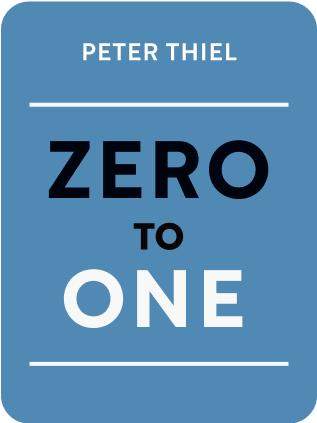

This article is an excerpt from the Shortform summary of "Zero To One" by Peter Thiel. Shortform has the world's best summaries of books you should be reading.
Like this article? Sign up for a free trial here .
What is building a monopoly? Should you try to build one as you’re building or expanding your company?
Building a monopoly is no easy task. Peter Thiel argues that building a monopoly allows a company to focus on innovation, and all the best companies, like Google, are building monopolies every day.
Building a Monopoly and the Myth of Competition
Monopolies are good for society. While it may seem counterintuitive, they can be more ethical, treat workers with greater consideration, and create more value than companies locked in competition do. But what goes into building a monopoly?
Competitors are caught up in a daily struggle for survival. For instance, with their low margins, restaurants have to do everything possible to minimize expenses—which can include paying minimum wage to employees and putting family members to work for nothing. In survival mode, money is everything.
In contrast, in a monopoly where profits are assured, there’s room to consider other things besides money. For instance, lacking intense competition, Google can give consideration to its workers, its products, and its impact on society.
Monopolies’ bad reputation comes from sometimes earning outsized profits at the expense of society. Certain monopolies corner the market on something that’s needed and jack up the price; customers have no choice but to pay it. This works for the owners in a world where nothing changes, like in the game of Monopoly, where you control as much real estate as you can, but you can’t create new real estate.
In contrast, creative monopolies do good and drive social progress because they operate in a different environment, a dynamic one. Instead of controlling all the options like Monopoly real estate, they create new options. They expand consumers’ choices by creating new categories of things. By adding value, creative monopolies make society better. But in order to have them, we need people who know how to create a monopoly, and do it right.
Monopoly Characteristics
Want to know how to build a monopoly fast? Monopoly businesses with strong future cash flows share several characteristics:
- Proprietary technology: This may be your greatest possible asset because it makes your product difficult to copy. For example, proprietary technologies used in Google’s search algorithms for aspects such as query autocompletion make the search engine hard to replicate. For proprietary technology to give you a monopolistic edge, it needs to be at least 10 times better in some major way than anything like it. Anything short of a dramatic difference will seem incremental and unimportant.
- Network effects: A network effect is the way additional users improve the value of a product or service for all users. For example, the more your friends use Instagram, the more value you get from being on it too. To generate network effects, your product has to be immediately valuable to its earliest adopters and then grow from there. A network business has to work on a small scale before it can go big—in fact, you have to plan on starting small. Mark Zuckerburg started Facebook by getting just his Harvard classmates to sign up.
- Economies of scale: A monopoly gets stronger as it grows because the fixed costs of creating a new product (like office space and engineering or development) are spread over a greater volume of sales and the cost per unit declines. When starting a business, you should build in the capability of scaling. For example, Twitter enjoys built-in scale: it can keep increasing the number of users without adding customized features.
- Branding: Creating an unassailable brand is integral to having a monopoly. For example, Apple is the most powerful technology brand. Everything from product design (including look and materials), to store design, price, and advertising contributes to an overall impression that Apple products are like no other. Of course, branding alone isn’t enough—you also need substance. Apple’s market dominance is based on superior products backed by an array of proprietary hardware and software technologies.
Building a Monopoly
Here are the steps to building a monopoly. Of course, a monopoly isn’t built overnight, but these are the steps you’ll want to have in mind for success in how to build a monopoly.
Discovering a secret: Creating a great business that no one else can compete with starts with discovering and building on a secret. It can be an untapped opportunity or a different way of looking at a problem. For example, Airbnb recognized and connected a supply of unoccupied lodging with travelers’ demand for affordable and unique accommodations. The founders of Uber and Lyft built billion-dollar businesses by connecting people who needed rides with drivers willing to provide them. Believing in secrets (untapped potential) and looking for them enabled these entrepreneurs to see an opportunity no one else noticed.
Also critical to a monopoly startup’s success is how you choose and expand your market. Start with a small market because it will be easier to dominate than a large one.
But make sure that your intended market really exists. PayPal’s first market—PalmPilot users who wanted to send money to each other—was essentially nonexistent. PalmPilot users were scattered around the world and had little in common, so not many of them needed to send money to each other.
After dropping that idea, PayPal targeted eBay auctions and found success by serving 25% of a few thousand high-volume power sellers who really needed a way to receive payments online. It’s better to focus on a small number of customers involved in a common activity or concentrated in a particular environment with no competitors than to reach for millions of disparate users.
Sometimes entrepreneurs think they’ll profit by getting a small share of a huge market—for instance, 1% of a $100 billion market. But even if you get a foothold in the market, as a small player, you won’t make money because competition will eat up your profits.
Expanding
Once you’ve dominated a small market, slowly expand into related markets that are a bit wider. This is the next step in building a monopoly.
This was Amazon’s approach. Jeff Bezos’s long-term goal was to dominate online retail, but he chose to start by selling only one thing—books. Amazon quickly became the dominant source of books for people who didn’t live near a bookstore or who wanted books not available in their area.
After a successful start with books, Amazon’s options for scaling up were to either increase the number of book customers (readers) or expand into similar markets. The company began selling CDs, videos, and software and gradually expanded to other categories until it became the dominant online retailer.
eBay also started small, focusing first on Beanie Baby collectors, then moved on to other collectors and hobbyists before ultimately becoming the top auction marketplace for selling something online. However, eBay learned there are limits to scale. It found that the auction model worked better for selling distinctive products like coins and stamps than for commodity items like pencils, which were easier to buy on Amazon than to bid for on eBay. eBay is still a successful monopoly, although smaller than originally envisioned.
Don’t Be a Disrupter
Being a disruptor is appealing. But the next step in how to build a monopoly is not to be a disruptor. “Disruption” continues to be a buzzword in Silicon Valley, but for startups, the concept can limit or distort your thinking and thus undermine success.
Originally, disruption meant the strategy of using new technology to make and sell a product cheaply, then gradually improve it and surpass high-end versions sold by competitors using older technology. PCs disrupted the market for mainframe computers; at first they seemed insignificant, but they eventually displaced mainframes. Similarly, mobile devices are disrupting the market for PCs.
However, the term disruption has since come to mean little more than changing or improving something. When entrepreneurs think of their companies as disrupting a market, they’re focusing on things as they currently are, rather than coming from a new perspective. It’s far more important to focus on the new product you’re creating than on how old companies will react to it. If your company is fixated on disrupting existing companies, then it isn’t entirely new and isn’t likely to become a monopoly.
Disruptive companies also get into losing battles. For example, in 1999, Napster tried to disrupt the music recording industry but ultimately ended up in bankruptcy.
While some might view PayPal as disruptive, it didn’t challenge an existing company. PayPal took some business from Visa initially, but it actually ended up helping Visa by expanding the market for online payments overall. PayPal created a positive dynamic, while Napster aimed to eliminate an industry.
As you expand your startup into related markets, don’t try to be a disrupter. Instead, avoid competitive markets. These are the beginnings of how to build a monopoly.
Be a ‘Last Mover’
The “first mover advantage” means getting into a new market first and gaining a substantial share of the market before anyone else gets there. This is essential in learning how to create a monopoly.
But moving first is a tactic, not a goal.” Your goal is to generate cash flows for the future. You do this by starting with a small slice of the market (being the first mover) and gradually expanding, dominating each new slice until you own the ultimate market for your product. You want to be the last mover—the one who makes the last spectacular improvement in a market that ensures years of monopoly profits.
Being a first mover puts you in position to be the last mover.
Understanding how to create a monopoly may not be your first order of business when you’re preparing to launch your startup. But keep building a monopoly in mind as you create your business plan.

———End of Preview———
Like what you just read? Read the rest of the world's best summary of Peter Thiel's "Zero To One" at Shortform .
Here's what you'll find in our full Zero To One summary :
- Why some companies genuinely move the world forward when most don't
- How to build a company that becomes a monopoly (and why monopolies aren't bad)
- Silicon Valley secrets to selling products and building rockstar teams






